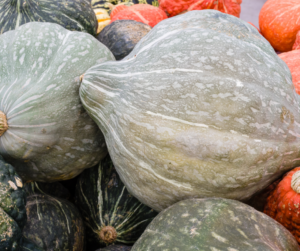The autumn harvest is well upon us, and with that we get an amazing variety of winter squash. From butternut & delicata, to acorn & carnival squash, it sure is fun to see what we can do with these colorful and oh so delicious edible gourds. Without further adeiu, here’s your guide to winter squash, so you would know exactly what to do with it when they come in your farm box.
-
Butternut

Outside of Pumpkin, butternut may be the most common and recognizable of the winter squashes. It gets it’s name from the flesh being as smooth as butter and sweet as a nut. You can use this bowling pin shaped squash pretty much any way you’d use a pumpkin. Use a 1:1 ration when choosing butternut over pumpkin for pies, cakes, or soups & when you bake or stuff butternut, the skin softens and is edible (unlike pumpkin).
2. Acorn

Acorn squash has a very similar taste to butternut & pumpkin, but it is more fibrous. So the best ways to enjoy acorn squash are baked, stuffed, or roasted. Very easy to identify by it’s acorn shape, you’ll want this squash more as a side dish, and less in soups or desserts.
3. Delicata

Delicata squash may be the easiest to cook, since the skin is thin before cooking, and it can be sliced and roasted, so cooking is done quicker than thicker skinned squashes. You can identify delicata by it’s long shape, with yellow skin and green/orange stripes. If you missed our delicata squash blog, you can read it here & learn all you need to know!
4. Hubbard

This large bumpy squash can be green or orange and is another one that can be a good substitute for pumpkin. In fact, it may even have more of a similar texture and flavor to pumpkin than butternut. The skin is not edible, and is on the thicker side. A little trick to make it easier to cut, is poke some holes in it and pop it in the microwave for 3 minutes. Then cut in half & roast. Scoop out the flesh after the hubbard squash is cooked.
5. Kabocha

Kabocha squash has a sweet nutty flavor, like a cross between sweet potato and pumpkin, and the texture is actually fluffy. The skin is edible and on the thinner side, which makes kabocha squash very versatile for soups. sliced & roasted, stuffed, and even in desserts like pudding & custards.
6. Carnival

These speckled little squash are a hybrid of the acorn and sweet dumpling squash (a squash that is shaped like a butternut and colored like a butternut), has hints of maple and a nutty flavor when roasted, and can also be sliced into salads when raw. You can eat the skin of a carnival squash.
7. Spaghetti

We see this squash the most, and it is set apart from all of the other winter squashes above. The fibrous flesh & very mild flavor not only give the spaghetti squash it’s name, but make it a yummy pasta for keto & paleo diets.
8. Pumpkin

What winter squash guide would be complete without pumpkin? We know you know what it looks like & what to do with America’s favorite holiday squash. But did you now how it got its name? French explorer Jacque Cartier saw them as large melons, or “gros melons” and the term translated into English is “pompions”, which evolved into the word pumpkin.
Now that you know what sets each squash apart from others, go ahead & relish in your fall farm box goodies. If you want to identify even more winter squash, take a look a the New York Times list-it’s got some fancy ones on there!

